In a 2dimensional Work of Art How Do You Make a Shape Appear Flat to the Viewer?
What is Shape in Art?
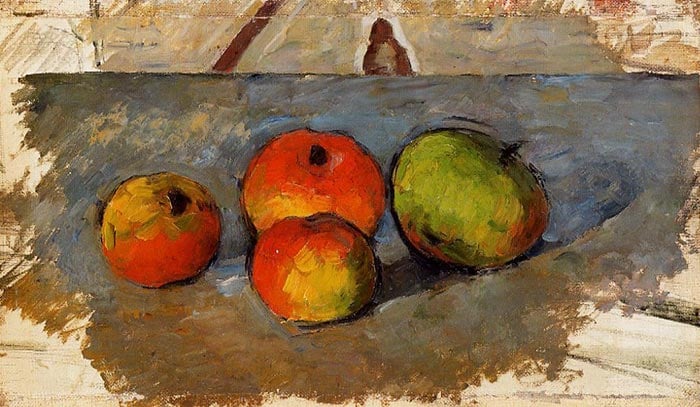
Paul Cézanne, Iv Apples, 1881
Shape is one of the visual elements which refers to an enclosed ii-dimensional area. You create a shape whenever you depict a line that connects at both ends.
In this mail, I discuss the different types of shapes you will encounter in fine art, how to apply them, and provide master painting examples.
Geometric and Organic Shapes
There are 2 major types of shape in art: geometric and organic.
The geometric shapes are mathematical and include squares, circles, and triangles. Get familiar with these geometric shapes every bit they grade the foundation for any subject field you pigment.
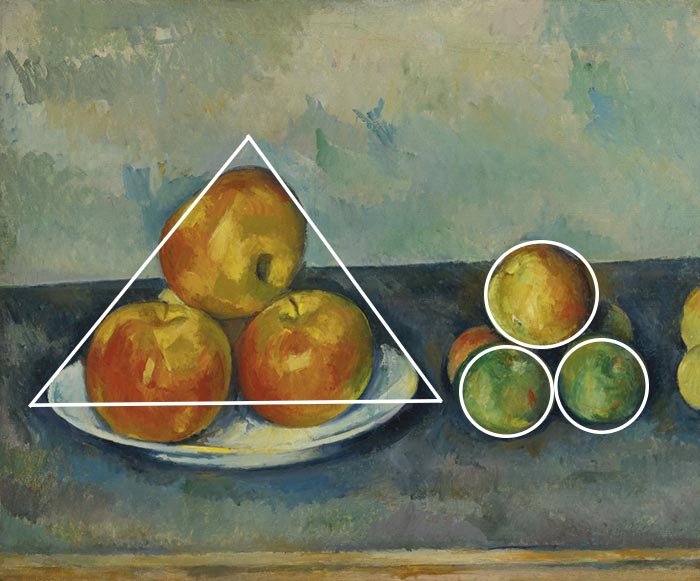
Paul Cezanne, Apples, 1890
Organic shapes are irregular or asymmetrical. You will run across them often when painting the landscape (think of the shapes which make up clouds, trees, or rocks).

Isaac Levitan, Evening Bells, 1892
Shape and Simplification
When you start a new drawing or painting, one of your offset tasks is to break the discipline down into basic shapes. Instead of seeing trees, rocks, grass, and sky, you should see squares, circles, triangles, and organic shapes. A subject area will exist much less confronting once you have broken information technology down into these bones shapes. Instead of having to solve one large and challenging puzzle, you tin can solve several smaller just easier puzzles.
I will evidence you what I mean using the reference photos below from New Zealand, taken whilst walking the Routeburn track. If I were to paint this, I would need to commencement interruption it down into basic shapes to aid me brand sense of the countless shapes, lines, colors, values, and details.

Below are the of import shapes which I see. With my initial sketch, I would at the very least try to capture these shapes. Detect how the shapes are created by changes in color, space, object, or light.

This is something you can practice without even picking upwardly a paintbrush. Look around you whenever you have some reanimation and break down what you lot see into basic shapes. Over time, yous volition start to meet these shapes instinctively.
Positive and Negative Shapes
Positive and negative shapes refer to the shapes created by changes in space. Positive shapes represent the space where objects be, whilst negative shapes represent the space between those objects.
For example, in the painting below by John Vocaliser Sargent, the female effigy and table are positive shapes. The background and flooring are negative shapes.

An interesting bespeak regarding positive and negative shapes is that they tend to influence each other. If you brand a positive shape larger, the surrounding negative shape tends to get smaller, and vice versa.
For case, say you are painting a tree and you demand to make information technology larger in the composition. Ane pick (the obvious i), would be to brand the tree larger. The other option would exist to cutting into the tree with the surrounding negative shape which represents the sky.
Y'all could too make a positive shape appear less solid and distinct by painting in some smaller, negative shapes. I did this in the painting beneath. The calorie-free blue and imperial negative shapes help intermission up the trees in the foreground to make them appear less solid and rigid.

Dan Scott, Queenstown, New Zealand, 2019
Light and Dark Shapes
Another manner to remember almost shape is in terms of light and dark (or lite and shadow). This will aid you continue your lights distinct from your darks, which is an important office of representational painting.
The abstract arrangement of light and night shapes is an important chemical element of pattern and is known as notan. Beneath is an example using a portrait past Giovanni Boldini. When you simplify the lights and darks into 2 values, you are left with an abstruse notan design. Find how with just these ii shapes, you still get a sense of the female figure. A potent notan design can form a powerful foundation for the rest of your painting.

Giovanni Boldini, Daughter With Black Cat, 1885
Changes in lite can create shapes even when there is no alter in object or space. For example, in the painting below, shapes are created on the grassy land simply by changes in light, even though the surface is flat.

Below is another example of this by Alfred Sisley. Notice the strong shadows cast by the haystacks.
Tip: Cast shadows tend to be sharp and distinct, whilst form shadows tend to be softer.

Alfred Sisley, Haystacks, 1895
(If you lot want to larn more than about value, yous might be interested in my Painting Academy form.)
Large and Small Shapes
When you offset breaking your subject down into basic shapes, first look for the largest, most dominant shapes, and then work down from there towards the smaller, more intricate shapes.
Permit me show you what I mean by using the post-obit painting by Edgar Payne every bit an instance:

Edgar Alwin Payne, Sunset, Canyon De Chelly, 1916
I take mapped out the dominant shapes below. These shapes make up the fundamental structure of the painting.

I can and so interruption down those dominant shapes into smaller, more intricate shapes. These are the shapes that you volition need to focus on afterwards in the painting.

Other Examples of Shape in Art
Shape tends to be a stiff characteristic in most urban scenes due to the rigid nature of architecture. In Alfred Sisley'southward Church in Moret, at that place is a cute coaction between positive and negative shapes, light and dark shapes, and geometric shapes created by the architecture.

Alfred Sisley, Church building in Moret, 1889
In Sargent's painting beneath, discover all the interesting shapes created as the planes of the rocks change from light into shadow. These shapes are emphasized by a contrast of warm lights against cool darks.
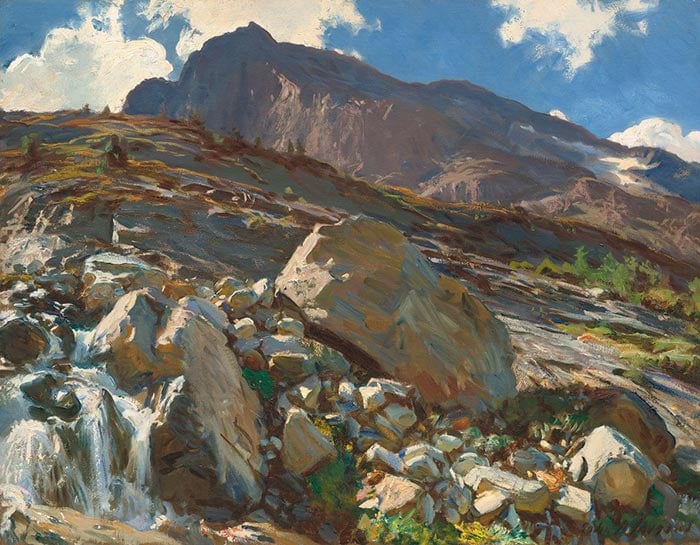
John Vocalizer Sargent, Simplon. Pass, 1911
In Monet's turbulent seascape, a powerful negative shape is created past the gap in the cliff. As well, find the organic shapes which brand upwards the h2o (you may demand to squint to simplify the values).
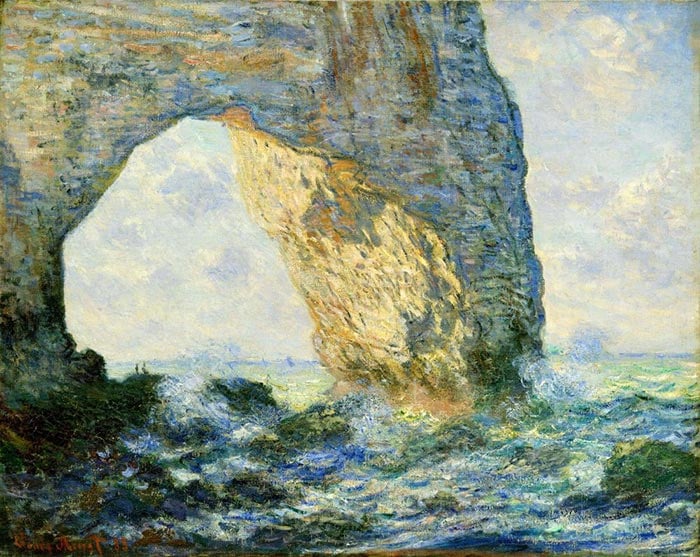
Claude Monet, Curvation to the West from Etretat, 1883
Edgar Payne was known for his stylistic apply of shape for painting the landscape.
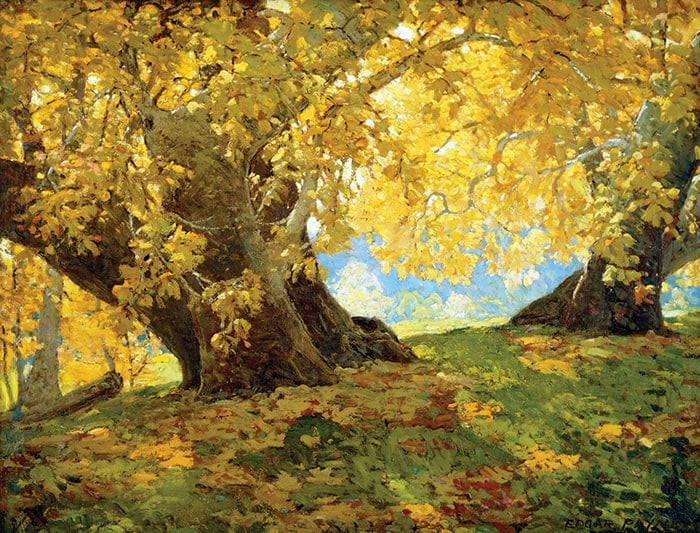
Edgar Alwin Payne, Sycamore in Autumn, Orange County Park, c.1917
Detect how simplified and curtailed the blue mountains are in the painting beneath.

Edgar Payne, Mountains
Below is another example of using shape to paint the landscape, specially for the rigid mountain.

William Wendt, Where Nature Created past God
Below is a great case of simplifying the shapes by Winslow Homer. Notice how y'all can suspension the background into three dominant shapes (the clouds, the light sky, and the grass). With regard to the rocks, notice how simply the prominent rocks are outlined, whilst the rocks in shadow are left vague and ambigous. All this draws attention to the female person figure sitting in the middle, who is painted with crisp and intricate shapes.

Winslow Homer, Peach Colour, 1878
Additional Readings
If yous want to learn more than about this topic, y'all should cheque out my posts on the principles of fine art and the other visual elements.
Thanks for Reading!
Thanks for taking the time to read this post. I appreciate it! Experience free to share with friends. If you want more painting tips, check out my Painting Academy course.
Happy painting!

Dan Scott
Draw Pigment Academy
Source: https://drawpaintacademy.com/shape/
0 Response to "In a 2dimensional Work of Art How Do You Make a Shape Appear Flat to the Viewer?"
Post a Comment